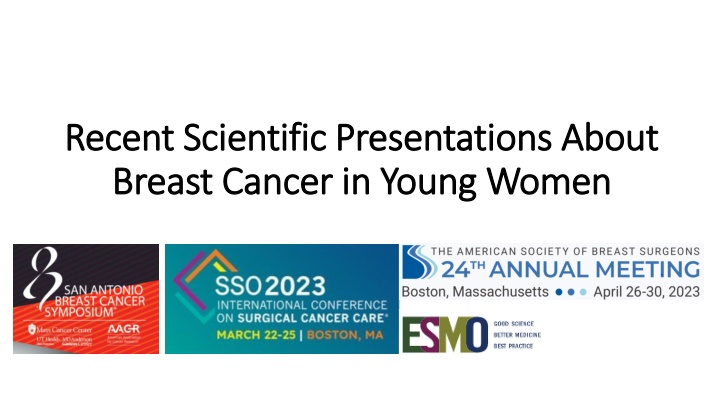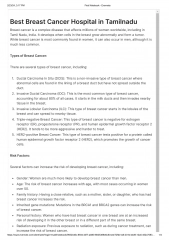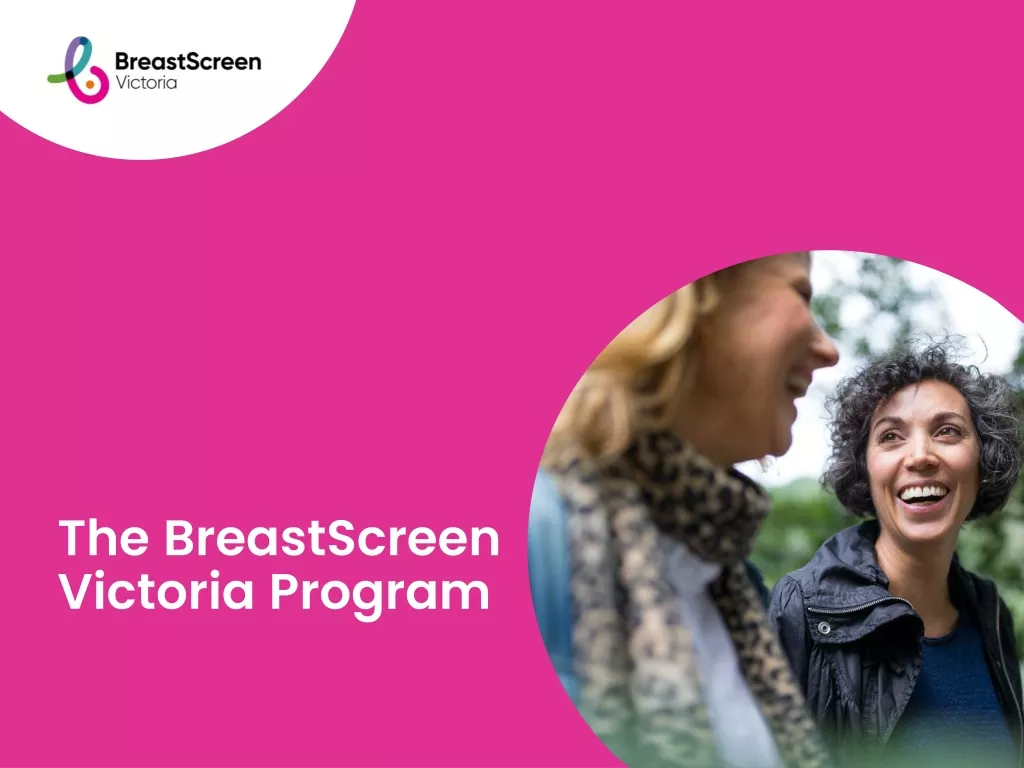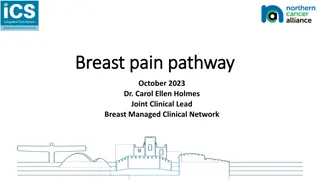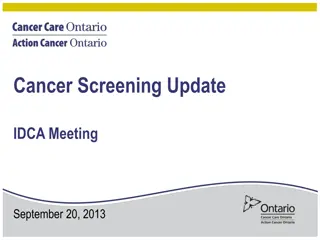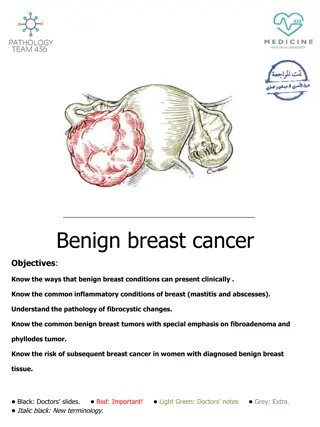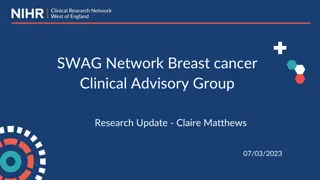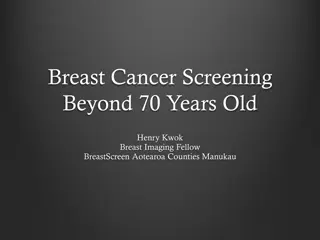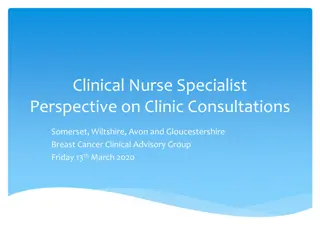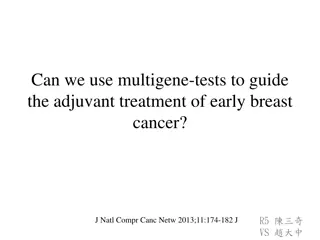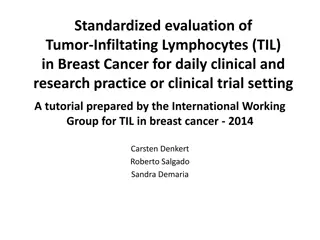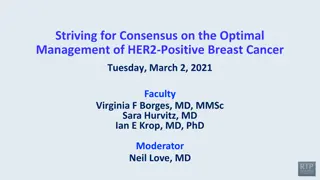Insights on Breast Cancer in Young Women: Diagnosis Challenges and Fertility Preservation
Recent scientific presentations shed light on delayed diagnosis of breast cancer in young women, highlighting the need for increased education and awareness. Findings indicate a concerning rate of delayed diagnoses, with many patients lacking essential breast health education. Moreover, research on embryo utilization post-fertility preservation in breast cancer patients reveals disparities in pursuing childbearing, particularly influenced by race and insurance status.
Download Presentation

Please find below an Image/Link to download the presentation.
The content on the website is provided AS IS for your information and personal use only. It may not be sold, licensed, or shared on other websites without obtaining consent from the author.If you encounter any issues during the download, it is possible that the publisher has removed the file from their server.
You are allowed to download the files provided on this website for personal or commercial use, subject to the condition that they are used lawfully. All files are the property of their respective owners.
The content on the website is provided AS IS for your information and personal use only. It may not be sold, licensed, or shared on other websites without obtaining consent from the author.
E N D
Presentation Transcript
Recent Scientific Presentations About Recent Scientific Presentations About Breast Cancer in Young Women Breast Cancer in Young Women
Delays in Diagnosis of Adolescent and Young Adult Breast Cancer and Lack of Breast Health Education Online survey via social media to women diagnosed < 40 years old, w 455 responses. RESULTS: 70% of respondents (n=320) required extra steps to obtain a diagnosis. 36% of survivors faced delays (>8 wks from detection to diagnosis). 62% of survivors never received breast health education prior to diagnosis from a physician 54% unfamiliar w/ breast self-awareness (BSA) and 54% incorrectly defined breast self-exams DISCUSSION: These data confirm earlier findings: 1) women under 40 face a significant rate of delayed diagnosis 2) patient perceptions and medical provider perceptions contribute to these delays. Earlier diagnosis of breast cancer in young women will initiate quicker treatment interventions which have been shown to increase 5-year survival rates and lower long-term mortality rates CONCLUSION: Greater efforts should be made to educate young women on breast health, and the medical community should be made aware of these challenges M Peters et al
Embryo Utilization in Young Breast Cancer Patients Who have Undergone Egg Harvesting for Fertility Preservation - Limited investigation of the ultimate issue in fertility preservation, namely the frequency with which women who have undergone egg harvesting actually pursue childbearing - RESULTS: 316 breast cancer patients of reproductive age were identified, 2010-2020 Of these, 168 patients (53%) were offered fertility referral and 118 (38%) saw a fertility specialist. 91 patients (29%) pursued egg harvesting followed by cryopreservation in 49 cases and embryos in 41; 1 unknown. Over an average of 5 years of follow-up (range: 2 - 12 years), 28 women (31% of those who pursued egg harvesting) utilized the egg or embryo to pursue childbearing. 17 underwent embryo transfer to themselves 11 used surrogate carriers. To date, this has resulted in 20 childbirths from 24 pregnancies. Four pregnancies are underway and 1 woman is awaiting embryo transfer. Four patients who had undergone egg harvesting conceived without fertility intervention. Weltz et al
Embryo Utilization, cont. - Of the 55 Medicaid patients of reproductive age diagnosed with breast cancer, only 8 (15%) met with a fertility specialist, 4 harvested eggs, and none pursued childbearing. HMO/PPO insured patients were significantly more likely than Medicaid patients to pursue egg harvesting and embryo utilization (X2 = 7.320, df = 2, p = 0.026). Of 260 HMO/PPO insured pts, 110 (42%) met w/fertility expert, 87 harvested eggs, 28 had embryo transfer. Due to small sample size, analysis did not yield statistically significant differences across groups (p=0.067). Nevertheless, apparent racial disparities exist. 5 of 17 (29%) Asian patients, 22 of 62 (36%) White patients utilized embryos as opposed to Black patients (1 of 4 or 25%), Hispanic patients (0 of 4 or 0%) and other (1 of 4 or 25%). CONCLUSIONS: These data demonstrate a low overall rate of cryopreserved egg and embryo utilization among women treated for breast cancer whose earlier pursuit of egg harvesting was evidence of a desire for childbearing. Furthermore, racial and insurance data demonstrate disparities in the pursuit of fertility treatment and utilization of preserved eggs and embryos. Further research will utilize interviews to analyze individual women s decision-making process relevant to such issues as hormone therapy utilization, concerns about breast cancer recurrence, progression of disease and restraints imposed by relationship status and finances.
Conception and Pregnancy Among Young Breast Cancer Survivors Participants: stage 0-III BC in Young Women's Breast Cancer Study (NCT01468246), a multi-center, prospective cohort of women diagnosed age 40 from 2006-2016 who reported 1 live birth after Rx Survey assessed conception, use of assisted reproductive technology ART), pre-implantation genetic testing (PGT), endocrine therapy (ET), and peripartum complications. Summary statistics are presented. Results: 92/119 eligible women completed the survey (response rate: 77%). Median time from diagnosis to delivery was 58 months (range: 11-154). Most women had stage 2 BC (43%, 40/92); 68% received chemotherapy 963/92); about half (51%, 47/92) were nulligravida at diagnosis. Overall, 61% of pregnancies were conceived naturally (56/92) and 39% with ART (36/92): 32% by in-vitro fertilization (IVF, 29/92), 7% with fertility medications only (6/92), and 1 with IUI. 38% of IVF pregnancies conceived using products from fertility preservation prior to BC Rx (11/29). Among women who used ART, 74% attempted to conceive naturally (25/36) for a median of 9 (range: 2-48) months prior to pursuing ART. The most common reasons for pursuing ART include infertility following BC treatment (33%, 12/36) and expediting conception to resume treatment (17%, 6/36). Sorouri et al
Conception and Pregnancy, cont. 11% of those with known inherited pathologic variant mutations underwent PGT (2/19). Reasons for not pursuing PGT included belief in more effective cancer risk reduction in the future (29%, 5/17), not being offered PGT (24%, 4/17), high cost (12%, 2/17), no interest in IVF (12%, 2/17), acceptable odds for inheriting the mutation (24%, 4/17), and belief in other risk reduction strategies (18%, 3/17); 1 woman reported ethical concerns. Conclusion: Among young BC survivors with a live birth following diagnosis, most conceived naturally, with the majority who used ART first attempting natural conception. There was limited use of PGT among mutation carriers with 25% not having been offered testing. Patient reported peripartum complications appear consistent with population norms, though the relatively higher rate of HDP bears further research. Among those yet to complete their ET, a notable proportion did not resume following delivery. This novel data may help to inform the care of young breast cancer survivors pursuing pregnancy.
Utilization of the OncotypeDX Assay for Young Patients with Early-Stage, Hormone Receptor-Positive, HER2-Negative Breast Cancer in an Integrated Health System Previous studies demonstrated reduction in chemotherapy in patients with a low ODX Recurrence Score (RS). Over recent years, utilization of this tool has increased in young breast cancer (YBC) patients (age 40 years), a population often underrepresented in randomized clinical trials. The purpose of this retrospective study was to assess the utilization of this assay over time in an integrated health system and whether ODX RS results altered clinical practice. Results: From 2008-2018, 1,436 Stage I-III YBC patients were diagnosed with invasive breast cancer, and 455 met eligibility criteria for ODX testing. Prior to 2018, 52.1% of patients were tested; after 2017, ODX testing rate increased to 88%. Overall, there were 255 patients who underwent ODX testing (55.9%). There was no overall difference in testing based on ethnicity (p=0.42). Adjuvant chemotherapy was administered to 61.0% (122/200) patients who were not tested, whereas 38.4% (98/255) of those tested received chemotherapy (p< 0.001). In tested patients, 6% of low-risk (RS 0-15), 37% of intermediate risk (RS 16-25), 92% of high risk (RS >25) patient received adjuvant chemo There were no differences in recurrence based on ODX testing, 11.0% (22/200) not tested vs. 9.4% (24/255) tested (p=0.26).
OncotypeDX for Young Patients Conclusions: - Utilization of ODX testing increased after 2017. - A significantly lower proportion of women who underwent ODX testing received chemotherapy, compared with women not tested for ODX. - A higher percent of women with T2 cancer received chemotherapy if testing was not completed, which may reflect a greater fear of recurrence in younger patients. - Further investigation is needed to better understand this potential risk of overtreatment in the YBC population.
Impact of Genomic Testing and Chemotherapy on Survival in Women Diagnosed with Breast Cancer Under Age 40 Brennan et al
Racial/Ethnic Disparities in Overall Survival among Young Women with Triple Negative Breast Cancer and Residual Disease after Neoadjuvant Chemotherapy INTRODUCTION: Studies have shown that pCR to neoadjuvant chemo correlates with improved OS for patients with TNBC. While race/ethnicity and SES variables can influence access to care and treatment, it is unclear whether these variables influence OS in patients with TNBC who have residual disease. METHODS: Patients < 50 yrs with stage I-III TNBC diagnosed 2010-2019 who received were reviewed in the National Cancer Database (NCDB). Race/ethnicity groups were defined as Hispanic (H), Non-Hispanic White (NHW), Non- Hispanic Black (NHB), Non-Hispanic Asian (NHA) and Non-Hispanic Other (NHO). RESULTS: Of the 16,416 patients identified, 66.3% (n=10,890) had RD after NAC. Rates of RD were highest for NHB (70.8%), while NHA (66.6%) and H (65.5%) had similar rates of RD compared to NHW (64.6%). Among those with RD, NHA (HR=0.61, 95% CI 0.48-0.79, p< 0.001) and H (HR=0.80, 95% CI 0.68-0.94, p=0.008) had improved OS compared to NHW after adjusting for select covariates. Although NHB had higher rates of RD, NHB race was not independently associated with worse OS (HR=1.07, 95% CI 0.96-1.19, p=0.22). CONCLUSIONS: Rates of RD after NAC for young women with TNBC vary by race/ethnicity, with NHB patients having the highest rates of RD. However, among those with RD, NHA and H race/ethnicity groups had better OS while NHB had similar OS compared to NHW. While most SE factors were not associated with OS, insurance type was significant. Beyond SE factors, race/ethnicity remained significantly associated with OS in young patients with TNBC and RD after NAC Parrish et al
